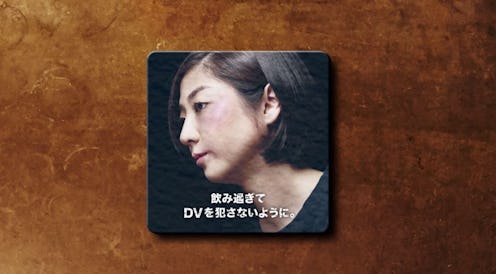
Domestic violence is a growing problem worldwide, and alcohol and other substances are often involved. So in Tokyo, the Yaocho chain of bars has begun a campaign to combat the issue. Working with the Japanese branch of creative agency Ogilvy and Mather, Yaocho designed a series of anti-domestic violence beer coasters — named "The Violence Coasters" — urging patrons to drink responsibly. While the campaign has good intentions, however, I feel that, like the Tinder Beater campaign, this one misses the mark somewhat.
Here's how the coasters work: Though at first they seem simply to depict Japanese women, placing a cold glass of beer on top of them reveals something more. Printed with thermochemical ink, the coasters react to the coldness of the glass — and as they do so, cuts and bruises appear on the women's faces. The tagline “Don't let excessive drinking end in domestic violence” runs along the bottom of the image.
The campaign is a clever use of technology, and again, its intentions are noble. Even so, though, it remains problematic for a number of reasons. Take, for instance, one of my initial reactions to it, which was the thought, “But men can be victims of domestic violence, too.” I might be missing some cultural context here — the gender dynamics in Japan are incredibly specific, and society has both traditionally been, and still is today, extremely patriarchal — but even so, it's demonstrably true that domestic violence in Japan still happens to both women and men.
In a 2006 survey conducted by the country's Gender Equality Bureau, 33.2 percent of female respondents reported experiencing physical assault, threats, or sexual coercion — as did 17.4 percent of male respondents. In most of these cases, the instances of violence began occurring after marriage. Furthermore, 13.5 percent of women respondents and 5.2 percent of men reported experiencing dating violence. Although more women in Japan suffer from domestic violence, men clearly do as well; as such, I feel the anti-domestic violence coasters missed something important by not acknowledging that both women and men can be victims.
The biggest issue, though, is this: With the tagline “Don't let excessive drinking end in domestic violence,” the campaign seems to put the blame for domestic violence squarely on alcohol. It's true that alcohol can raise aggression, which can in turn contribute to instance of domestic violence; furthermore, it's also true that alcoholism can change your personality, which might prompt behavior in which you otherwise might not engage. Addiction is very real, and it's an illness to be treated — not stigmatized.
But alcohol is far from the only reason domestic violence happens — and domestic violence is never, ever OK. The bottom line is that no matter how angry you are, or how frustrated you are, or whatever else you might be feeling, it is NEVER acceptable to take it out on someone else, either by hitting them or causing them psychological or emotional distress. Placing the blame for domestic violence on alcohol excuses the people who commit the crimes in the first place — which is classic abuser behavior. It's a variation on “Look what you made me do,” turning it instead into “Look what the alcohol made me do” — when what it really needs to be is, “I did this. I have a problem. And in order to fix it, I have to take responsibility for my behavior.”
Raising awareness about domestic violence is a worthy cause, and a necessary one. I wonder, though, whether it's actually possible for anti-domestic violence campaigns to succeed when they're in the form of printed advertisements. Print ads, by nature, must be brief: They paint in broad strokes so as to give us all the information we need in a passing glance. To accomplish this goal, whatever the ad is selling must necessarily be boiled down to its simplest form. But when the “sell” is a message about an issue as complex as domestic violence? You can see how some problems might arise — namely, that issues like this can't be expressed simply without doing them a disservice. Because of the problems inherent to advertising, I have yet to see an anti-domestic violence ad campaign that isn't flawed in some fundamental and extremely important way.
Maybe the point is that we need to take all of these anti-domestic violence campaigns together — that we need to look at them as parts of one picture, allowing each of them to fill in the blanks the others leave out. This, too, is a flawed method of delivery for the messages at hand; when all you see are pieces, it's easy to miss the larger point. But it — and, indeed, anti-domestic violence campaigns as a whole — is better than nothing. What they're all doing right is starting conversations, and keeping those conversations going. Visibility is key — and when we get to a point when we can no longer ignore what we're seeing? Then maybe we'll finally — finally — try to do something about it.
Find out more about the Yaocho Bars' "Violence Coasters" in the video below:
Images: Yaocho Bar Group/YouTube (4)